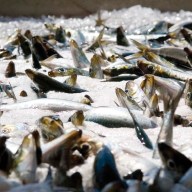MONTREAL – Guns and hand grenades have nearly wiped out many large animals and fish in Afghanistan.
But Canadian wildlife biologist Chris Shank has helped found the country’s first national park, providing safe haven to those creatures left behind after so many have become collateral damage in a country decimated by decades of war.
Band-e-Amir holds rare attributes for a national park: exotic animals here have been frequently shot, marine life gets blown up by fishermen who carry explosives instead of fishing gear, and the path into the park bypasses landmines.
In the midst sits a jewel of a region with rugged peaks and clear blue lakes in the Hindu Kush mountains of the central Bamiyan province.
It was inaugurated last April near the site where 1,500-year-old Buddha statues were reduced to rubble by the Taliban in 2001.
Its creation is a small victory, 30 years in the making, for the Alberta-based researcher who first saw its potential in the mid 1970s while working with a team of researchers from the United Nations.
Since 2006, after signing with the U.S. Wildlife Conservation Society to oversee environmental projects in Afghanistan, he’s been spending at least four months a year there championing ventures like Band-e-Amir.
“It’s a symbolic hurdle,” Shank admits. “This is not Banff National Park by any means.”
Some 5,000 people live on the preserve – grazing, fishing and farming – and it is a pocket of stability in a lawless land. The area is a far cry from the southern Kandahar province where Canadian soldiers are based.
But even here conflict has broken down social structures that used to ensure sustainable land use.
Soil degradation, overgrazing, deforestation and illegal shrub harvests are common.
Nature’s silence is often shattered by explosives used by fishermen to blast the lake waters. Snow leopards have vanished – killed off by illegal trade, hunting and poaching.
It poses a unique set of challenges for conservationists, but they hope Band-e-Amir will buffer the effects of habitat destruction on the wild goats, sheep, wolves, foxes, fish, and birds.
“Doing environmental work in Afghanistan is extremely difficult,” said Shank.
Conservation usually involves short-term sacrifice for long-term gain but, in a place with rampant poverty, “people don’t have that luxury,” he said.
“Wild animals and plants are not as important to them as education, health care and feeding their family.”
So Shank shifted the focus to what he calls ‘sustainable conservation’ over preservation.
“One of the major things that could benefit the environment would be to assist local people in establishing land rights,” he said.
He’s heartened by how the introduction of the concept of local governance has been a boon for stability in the region – something Shank sees as significant in terms of the national model.
“It’s given the people a sense of identity, enfranchisement in the management of their lands,” he said.
There’s a budding eco-tourism industry, with thousands of Afghan visitors flocking to the park on the one narrow track that has been cleared of land mines.
Band-e-Amir also provides jobs to locals trained as park rangers by the government and the conservation organization, funded by the United States Agency for International Development, and Shank says hunting has stopped due to education and enforcement.
Kabul is also on board.
In June, Afghanistan’s National Environmental Protection Agency released its first-ever list of protected species, which includes snow leopards, the Asiatic black bear, and the wild Marco Polo sheep whose curving horns can span up to six feet from root to tip. The list is expected to be expanded to some 70 species of plants and animals by the end of the year.
The government is also pushing for the region to be granted status as a World Heritage Site, which would offer additional protection to its natural wealth.
The Wildlife Conservation Society has plans to help develop a network of parks and protected areas, including bio-diversity hotspots, near Pakistan, China, and Tajikistan.
But after three decades of conflict and drought, the country has lost most of its wetlands and forests and Afghans are increasingly at risk for infections by poor waste management and spotty access to fresh water.
With 80 per cent of its citizens living directly off the land, environmental degradation is a threat to livelihoods and places the poorest Afghans particularly at risk.
For Shank, any small gains temper the daily failures and challenges of working in Afghanistan.
“It actually overcomes the disappointment,” he said, noting that problems he’s faced have sometimes felt insurmountable.
“No one really knows what’s going to happen in the future.”
But he continues to ramble through the countryside, conducting wildlife surveys, working with the 13 villages lying within the park, and convincing village elders – many of whom are former mujahedeen – to back the conservation projects they have so far cautiously approved.
He’s also working on establishing a second park in the Ajar Valley, though conflict has aggravated tensions between tribes, creating a major hurdle.
Still, Shank says he’s not worried about his safety and mostly stays with the local people.
“I’ve never felt unsafe in central Afghanistan,” he said.
“It’s not Kandahar all over.”
















